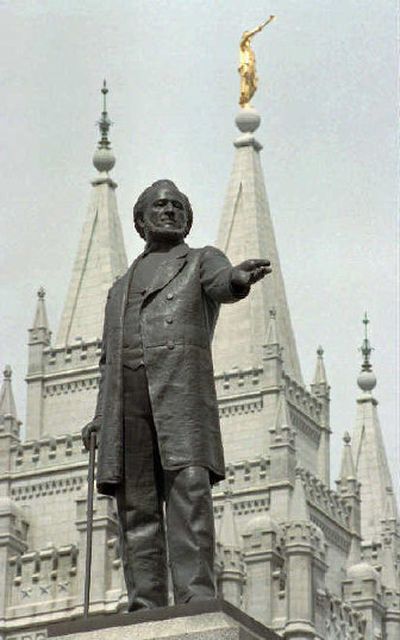Massacre revisited

One hundred fifty years ago, a glorious September morning in the Utah mountains morphed into Mormonism’s darkest hour when a skittish militia opened fire on a wagon train, leaving more than 120 men, women and children dead in a flowery field.
Now the “Mountain Meadows Massacre” is becoming more than a subject of somber reflection within tight-knit Mormon circles. Two new films and a forthcoming book aim to tell the nation what happened, why and – perhaps most important – whether the revered Mormon prophet Brigham Young ordered the killing to occur.
At stake are not just the details of a tragic moment in pioneer history. For the 5.8 million Americans who belong to The Church of Jesus Christ of Latter-day Saints, as the Mormon church is officially known, the integrity of one of their most important heroes hangs in the balance.
For others, the depictions stand to forge new impressions of a controversial religious minority that has known both violent persecution and substantial influence across its tumultuous 180-year history.
“As a society, we are definitely at a crossroads” in terms of rethinking Mormonism, says Alan Wolfe, director of the Boisi Center for Religion & American Public Life at Boston College. “This is a huge moment because it’s a very important religion.”
Throwing down the gauntlet is Christopher Cain’s movie, “September Dawn,” which opens next Friday in more than 1,000 theaters nationwide. Although the romantic storyline is fictional, the film claims to be historically accurate in tracing the massacre to Brigham Young and portraying 19th-century Mormons as obedient, bloodthirsty fundamentalists.
In one scene, for instance, an angry mob ignores a report that the wagon train’s “gentiles” are friendly and chants for “blood atonement!” in the form of death.
Other renderings, however, convey a more complex picture.
The PBS documentary “The Mormons,” which airs Monday and Tuesday (9 p.m., KSPS-7 in Spokane), explains that Mormons had suffered multiple, often bloody persecutions, which prompted their epic westward trek in the mid-1840s to settle in the Salt Lake Basin.
By 1857, federal troops were marching on the Utah Territory to depose the theocratic governorship of Brigham Young, and his followers were gearing up to defend their turf from yet another assault.
In that touchy environment, bullets flew and travelers died. The ensuing massacre ensured that no adult witnesses would survive.
“The important thing is to place the massacre in context,” says Helen Whitney, director of the PBS documentary. “They believed they were at war. The president was arriving with his troops. …
“All of this was swirling around – years of persecution, a kind of paranoia – it really was sort of an explosive mixture in which the brakes just didn’t hold.”
On the high-stakes issue of Brigham Young’s role, the official view from The Church of Jesus Christ of Latter-day Saints is simple: He had none.
Young sent a messenger to tell militiamen to let the travelers pass without interference, according to LDS spokesman Michael Otterson. The full case for vindicating Young will appear later this year in an Oxford University Press book written by three church historians.
As debate swirls, observers are theorizing why Mountain Meadows is gaining traction in popular culture. Hollywood tells a distorted version to increase ticket sales, Otterson says, and in the process actually validates Young’s stature as a prophet.
“Every prophet of the Old Testament and every prophet of the New Testament has come under criticism and ridicule from the establishment of the day,” Otterson says. “So it doesn’t surprise us that some people would want to throw rocks at the memory of Brigham Young.”
Although Mormons regard themselves as Christians, orthodox Christians reject key tenets of Mormonism, such as the exaltation of founder Joseph Smith to the status of prophet and the treatment of his Book of Mormon as Scripture.
Despite being controversial, Mormons recently have risen to unprecedented prominence in American society. Church members lead numerous well-known companies, occupy leadership positions in government and have a presidential hopeful in the well-financed GOP campaign of former Massachusetts Gov. Mitt Romney.
With all that in mind, some observers suspect a rising tide of anti-Mormonism accounts for today’s intense focus on Mountain Meadows.
Jan Shipps, professor emeritus of religious studies and history at Indiana University-Purdue University Indianapolis and an expert on Mormonism, doubts Young was involved in the massacre: “My sense is that Brigham Young was not that dumb as to order people to kill a wagon train” and stir up more ill feelings toward Mormons.
Nevertheless, she says, the prospect of implicating Young and his church in a historic tragedy appeals to modern-day critics.
Mormons used to live largely to the West, she says, but now “Mormons are everywhere. They are making converts that the evangelicals would like to make, so evangelicals are saying Mormons aren’t Christian.
“All of a sudden you get this, ‘We’re going to look at Mormon history, and we’re going to find out what’s really there.’ “
Historians on both sides of the debate agree that Americans shouldn’t infer too much about modern-day Mormons from current portrayals of their ancestors.
“Even if Brigham Young ordered (the massacre), would it mean the Mormon people are now disposed to violence?” Shipps asks. “I don’t think so.”